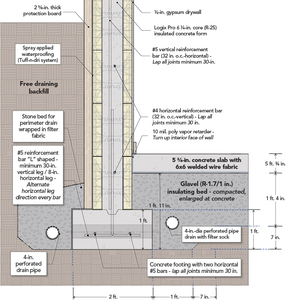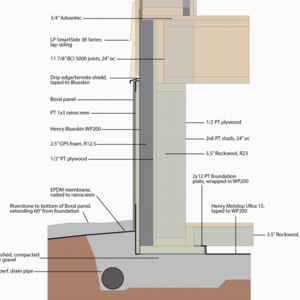
A GBA reader named Jason is seeking advice for a permanent wood foundation (PWF) that’s been subjected to ponding surface water and is now leaking.
The original dampproofing appears to be an asphaltic material that was sprayed or brushed on when the house was built in British Columbia 40 years ago. Located in climate zone 7A, the structure has a fully developed basement, insulated with R-20 fiberglass batts between the 2×6 studs, protected with what Jason describes as a “light” vapor barrier, and finished with drywall. There’s no sign of mold, but there are indications that water has been seeping through the seams of the sheathing on the outside of the foundation wall.
“The water ingress appears to be from surface water ponding and seeping through the sheathing at both the vertical corner and horizontal sheet joints around the back corner of the home where ponding on frozen ground has been occurring,” Jason writes in this recent Q&A post. “Initial interior inspection with drywall removed in the fall observed dampness over entire sheathing surface below grade, but the insulation wasn’t saturated and there are no signs of mold on the drywall. The vapor barrier was intact.”
He adds that a perimeter drain appears to be working, taking accumulated water in the wall cavities and directing it to a drain sump located in the basement.
In addition to dampproofing and joint repair, he’d also considering installing an underground roof membrane to direct surface water to a swale that also will capture water from multiple downspouts.
How should he proceed? That’s the focus of this Q&A Spotlight.
Get the water away from the house
“You absolutely must get that water away from the house,” says Kbentley57.
If there isn’t enough of a slope on the…
Weekly Newsletter
Get building science and energy efficiency advice, plus special offers, in your inbox.

This article is only available to GBA Prime Members
Sign up for a free trial and get instant access to this article as well as GBA’s complete library of premium articles and construction details.
Start Free TrialAlready a member? Log in















3 Comments
The “Fixing a Rotted Permanent Wood Foundation” title that appeared in a GBA email got my immediate attention having built and lived with a PWF basement for about 30 years and planning to use PWF for future construction. But as indicated in the actual article, the PWF was NOT rotting; it was simply leaking and so joins the millions of poured concrete, CMU, and every other type of basement wall construction where when the exterior drainage has a problem the basement wall leaks. The title should have been “Fixing a Leaking Basement”. The solutions are no different for a PWF than for any other type of basement construction.
Hi Entman,
Apologies for the confusion. I take fault and have edited the title to reflect your good point--thank you for bringing it to my attention. It's appreciated and provided a good lesson.
I understand. It caught my attention, too!
In South Dakota, they even pour slabs atop PWF footings.
I like this!
Log in or become a member to post a comment.
Sign up Log in